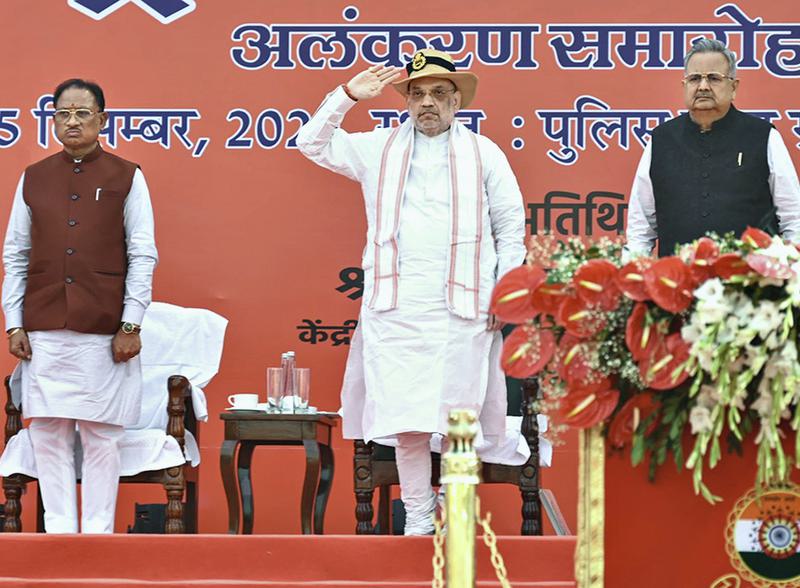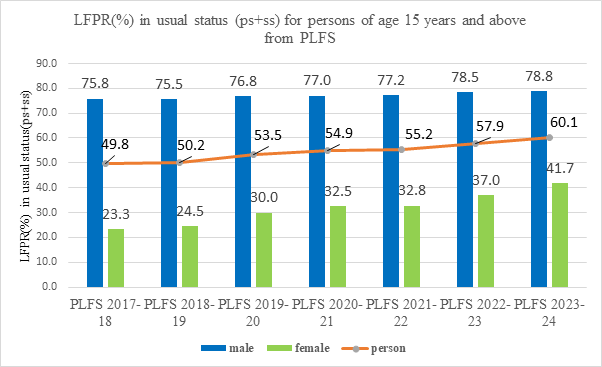Commitment to Eradicating Naxalism in Chhattisgarh by 2026

- 17 Dec 2024
Overview
Union Home Minister Amit Shah has reiterated India's commitment to eliminate Naxalism in Chhattisgarh by March 31, 2026. He emphasized the progress made in the fight against Naxalism, highlighting key successes and outlining the strategy for the coming years.
Key Pointers
- Government Commitment: Amit Shah emphasized the joint commitment of the Government of India and the Chhattisgarh state leadership to rid the state of Naxalism by 2026.
- Security Forces’ Success: Over the past year, Chhattisgarh police neutralized 287 Naxalites, arrested around 1,000, and saw 837 surrenders.
- Top Naxal Cadres Neutralized: The state forces successfully neutralized 14 high-ranking Naxal cadres.
- President’s Police Colour Award: Chhattisgarh Police received the President's insignia within 25 years, a significant achievement for the state.
The Three-Pronged Strategy for Eliminating Maoist Insurgency
- Security Measures (Force)
Deployment of Security Forces
- Enhanced Presence: Increased deployment of Central and State police forces in Left-Wing Extremism (LWE) areas.
- Joint Operations: Coordinated operations between state and central forces, including CRPF and COBRA units.
- Upgraded Technology: Incorporation of UAVs, solar lights, and mobile towers to enhance operational efficiency.
Operation SAMADHAN
- Key Elements:
- Smart Leadership: Leading with innovative strategies.
- Aggressive Strategy: Swift, decisive action against insurgents.
- Motivation and Training: Strengthening the capabilities of forces.
- Actionable Intelligence: Real-time intelligence for effective operations.
- Harnessing Technology: Using modern tech for strategic advantage.
2. Development Initiatives
Focused Development Schemes
- PMGSY: Rural road connectivity under the Pradhan Mantri Gram Sadak Yojana.
- Aspirational Districts Program: Improving infrastructure in Naxal-affected areas.
- Skill Development: Targeted schemes in 47 LWE-affected districts to reduce unemployment.
Infrastructure Development
- Special Infrastructure Schemes: Building schools, roads, and bridges in remote areas to integrate them into the mainstream economy.
- Rehabilitation: Focus on providing rehabilitation for former Naxals through education and vocational training.
3. Empowerment (Winning Hearts and Minds)
Public Engagement
- Tribal Empowerment: Strengthening communication with tribal communities to reduce alienation and mistrust.
- Rehabilitation Policies: Surrender schemes offering incentives like education and financial aid to reintegrate former insurgents into society.
Maoism: Ideology and Background
What is Maoism?
- Origin: A form of communism developed by Mao Tse Tung, focusing on armed insurgency to capture state power.
- Core Beliefs: Maoists believe in violence and insurrection as legitimate means to overthrow the state and establish a People’s Democratic Republic.
- Indian Maoism: The Communist Party of India (Maoist), formed in 2004, leads the largest Maoist insurgency in India.
Recent Achievements in Combatting Maoist Insurgency
Key Successes in 2023
- Maoist-Free Villages: Villages in Dantewada declared "Maoist-free," a significant victory for the state.
- Reduction in Security Forces’ Casualties: 14 deaths in 2024, a dramatic decrease from 198 deaths in 2007.
- Infrastructure and Logistical Support: Enhanced use of helicopters and fortified police stations.
Government’s Commitment to Rebuilding
- Rehabilitation and Welfare: The government is implementing policies to improve the living standards of affected families, including 15,000 houses for Naxal-affected regions.
- Economic Development: Focus on building infrastructure and providing employment through skills training programs.
Challenges in Eliminating Naxalism
Socio-Economic Issues
- Exploitation of Tribals: Marginalization of tribals due to displacement for mining and forestry.
- Lack of Infrastructure: Basic amenities like roads, schools, and healthcare are absent in many areas.
- Centralized Naxal Command: The CPI (Maoist) retains a strong leadership, despite fragmentation of its forces.
Governance and Trust Issues
- Alienation of Local Populations: Ineffective governance and poor implementation of welfare schemes fuel local support for Naxal groups.
- Resource Conflict: The Naxals exploit rich mineral resources in the region to fund their insurgency.
Way Forward
Governance and Economic Reforms
- Tribal Empowerment: Form Tribal Advisory Councils as per the Fifth Schedule for better resource management.
- Land Redistribution: Enforce the Land Ceiling Act to reduce inequality.
- Livelihood Programs: Offer alternative livelihoods to reduce dependency on illegal activities.
Security Measures
- Paramilitary Deployment: Specialized forces to secure tribal areas and enable local governance.
- Resource Management: Ensure sustainable exploitation of natural resources, involving tribal communities in the decision-making process.
Peace Dialogues
- Inclusive Policies: Engage in dialogue with Naxals to facilitate their reintegration into mainstream society.
Conclusion
Naxalism in India, particularly in Chhattisgarh, is a complex issue rooted in socio-economic inequalities, lack of development, and historical alienation of tribal communities. The government's approach, encapsulated in the SAMADHAN strategy, combines security operations with developmental initiatives and a focus on empowerment to tackle the problem. With a clear commitment to eliminate Naxalism by 2026, the Indian government is making significant strides in reducing violence, improving governance, and integrating affected communities into the mainstream.
PLFS REPORT 2023-24

- 26 Sep 2024
In News:
The Periodic Labour Force Survey (PLFS) conducted by the National Statistical Office (NSO) from July 2023 to June 2024 provides crucial insights into the employment landscape in India.
Key Findings from the PLFS Report 2023-24
- Labour Force Participation Rate (LFPR):
- The LFPR for individuals aged 15 years and above rose to 60.1%, an increase from 57.9% the previous year.
- For males, LFPR is at 78.8%, while for females, it increased to 41.7%, up from 37.0%.
- Worker Population Ratio (WPR):
- The WPR for the same age group stands at 58.2%. This is composed of 76.3% for males and 40.3% for females.
- Female WPR improved from 35.9% to 40.3% during the reporting period.
- Unemployment Rate (UR):
- The overall unemployment rate is 3.2%. It slightly declined for males from 3.3% to 3.2%, while it increased for females from 2.9% to 3.2%.
Overview of the PLFS
The PLFS, initiated in April 2017, aims to provide timely and accurate labor market data. It focuses on two main objectives:
- Short-term Employment Indicators: Measure key employment metrics every three months in urban areas using the Current Weekly Status (CWS) approach.
- Annual Estimates: Gather employment and unemployment data for both urban and rural areas, assessing them in terms of Usual Status and CWS.
Methodology and Sample Design
- The survey employs a rotational panel sampling design in urban areas, where households are visited multiple times to ensure comprehensive data collection.
- During the 2023-24 period, a total of 12,800 Field Sampling Units (FSUs) were designated, with 12,743 successfully surveyed.
Conceptual Framework
Key indicators measured include:
- Labour Force Participation Rate (LFPR): Percentage of the population working or actively seeking work.
- Worker Population Ratio (WPR): Percentage of employed individuals in the total population.
- Unemployment Rate (UR): Proportion of unemployed individuals among the labor force.
Challenges in Job Creation
India continues to face significant challenges in generating formal jobs. Key factors contributing to this issue include:
- Informalization of Employment: Growth in sectors like agriculture and construction is leading to increased informal employment, lacking social security and job protections.
- Technological Advancements: Automation and AI threaten job opportunities, even for skilled workers, as evidenced by layoffs in the IT sector.
- Skill Mismatch: Despite a push for skill development, the share of skilled jobs has declined, highlighting a growing disconnect between training programs and labor market needs.
- Policy Impacts: Past policies, such as demonetization and poorly implemented GST, have negatively impacted small and medium enterprises (SMEs), which are vital for job creation.
Way Forward:
To address these challenges, several strategies are proposed:
- Sectoral Diversification: Fostering investments in manufacturing, renewable energy, and technology can generate productive jobs.
- Support for MSMEs: Targeted financial aid and regulatory relief for micro, small, and medium enterprises are crucial for boosting their employment potential.
- Skill Development: Aligning training initiatives with current industry demands, particularly in emerging sectors, is essential.
- Focus on New-Age Services: Encouraging growth in sectors like e-commerce and online education could create diverse job opportunities.
Conclusion
The PLFS 2023-24 reveals an encouraging increase in labor force participation, particularly among women, while also highlighting persistent challenges in unemployment and gender disparities. The findings underscore the need for continued efforts to enhance job creation and improve employment conditions in both formal and informal sectors.
